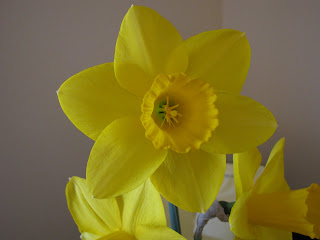Every winter I try to learn a little more about these wonder bulbs while the winter is waning and the anticipation of spring is on my mind. I pull out my book Daffodils for North American Gardens by Brent and Becky Heath of Brent and Becky’s Bulbs. There are lots of pictures which are a must for a winter starved gardener in Ohio, but there is so much information that helps me keep learning. The Daffodil Society provided great printed resources at the show, as well as very helpful society members who answered all kinds of questions. I am working on learning to identify the flowers by using the Royal Horticultural Society System of Classification. There are 13 divisions. The Division number indicates the form of the flower and the letters indicate the flower color. The daffodil Menehay is in Division 11(Split Corona) A(Collar Daffodil) Y(yellow)-O(orange). Below is an entry card for this daffodil.
My Virtual Garden Cat especially for my sisters and daughter
Tuesday, April 19, 2011
Central Ohio Daffodil Show
Monday, April 18, 2011
Spring at its Best
I was soon summoned to the backyard to check out a nest right smack in the middle of the Mulberry tree.
This tree is always so much fun to prune. Yeah!! If you don’t get to it before it leafs out, forget it. It becomes so dense with branches that it is impossible to find your way around. So, with a little coaxing and a pair of loppers in hand, my husband went out to tackle this fun job. This tree is really a fun tree if kept in check. We have seen a group of these at the Cleveland Botanical Garden They are in their Children’s garden and form a tent like structure which makes great child play.
Once my husband began to prune the tree, he noticed that there was a lot of squawking from two robins in another tree. He soon put things together. A finely woven nest was spotted with four beautiful blue eggs in it. Well that got our curiosity up.

I don’t know if my movement, while looking out the window, made mom fly away for a time, or if she just needed a break. We are not sure just how long these eggs have been in the nest and are a little worried that we have now removed some of the cover for mom and her eggs.
According to Wild Birds Unlimited, the male robin is the one that sings, but both male and female make alarm sounds. This must have been what my husband heard. Robins eat insects and berries. Check out these amazing facts: Robins can eat up to 14 feet of earthworms in a day!” Their life cycle is usually around one and a half years. Most of the nest is built by the female in about five to six days. The number of eggs in our nest is typical and mom incubates these eggs for approximately 12 to 14 days. It takes about 10 days for the babies to get all of their feathers. They leave the nest in 14 to 16 days. More to come later...

















